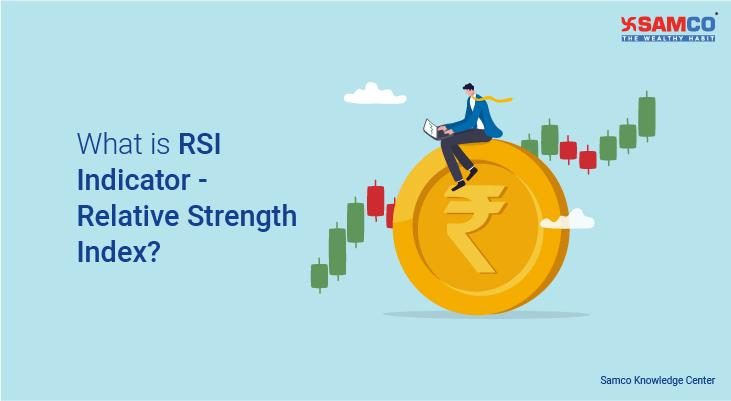Technical analysis involves the study of historical price data and market trends. It plays a crucial role in stock trading by allowing you to predict future price movements in an asset. Among the many price indicators used in technical analysis, very few are as versatile and useful as the Relative Strength Index (RSI).
The Relative Strength Index uses an asset’s price movements to indicate whether it has been oversold or overbought. Traders can use this information to identify potential trading opportunities and manage risk effectively.
In this comprehensive guide, we will break down what RSI in the stock market is and how it works. Additionally, we will also look into the RSI formula and how to use it to calculate the indicator manually.
What is RSI in the Stock Market?
The Relative Strength Index (RSI) is a momentum indicator developed by J. Welles Wilder Jr. in 1978. The technical indicator takes into account the price changes in an asset over a specified period, typically 14 days. Based on the price movements, a value is assigned, which indicates whether the asset is overbought or oversold in the market.
Overbought assets are more likely to go through a correction phase, whereas oversold assets are likely to rebound in the near future. Depending on the RSI values for an asset, traders can predict future price movements and time their entries and exits better.
How RSI Works
Now that you know what RSI in the stock market is, let us look at how it works. As a trader, there are three major aspects of the RSI indicator you must be aware of -
Range
To know how RSI works, you must first understand its range. The Relative Strength Index’s values move between 0 and 100 depending on the price movements of the asset.
Overbought Zone
The zone from 70 to 100 is known as the overbought zone. If the RSI of an asset is above 70, it often indicates that the stock is overvalued or has experienced excessive buying.
Oversold Zone
The zone from 0 to 30 is known as the oversold zone. If the RSI of an asset is below 30, it often indicates that the stock is undervalued or has experienced excessive selling.
In addition to identifying overbought or oversold conditions, the Relative Strength Index also reveals momentum strength and potential trend reversals. For instance, RSI readings near 50 often indicate a neutral zone where neither buying nor selling pressure dominates.
RSI Formula and Calculation
Understanding the RSI formula helps you calculate it manually. Here is the mathematical formula that is used to determine RSI in the stock market.
RSI = 100 - [100 ÷ (1 + RS)]
Where,
RS = average gain over the period ÷ average loss over the period
Here is a hypothetical example to help you fully understand how RSI works.
Assume there is a stock, ABC Limited. Over a 14-day period, the stock gained by 1.5% on average. During the same period, the stock experienced an average loss of about 0.5%. With these two values, we can first calculate the Relative Strength (RS) of the stock, which is as follows:
Relative Strength (RS) = 3 (1.5 ÷ 0.5)
Now that we have the relative strength, we can input the values in the above-mentioned RSI formula to get the value.
RSI of ABC Limited = 100 - [100 ÷ (1 + 3)]
RSI of ABC Limited = 100 - [25]
RSI of ABC Limited = 75
As you can see, ABC Limited has a Relative Strength Index of 75, which indicates that the stock is within the overbought zone. As a result, the asset could enter into a correction phase in the near future.
Now, although it is possible to use the RSI formula to make manual calculations, most charting tools these days have an RSI indicator tool. The tool makes the calculations automatically and displays the values. In fact, it even plots the values on a chart to make it more visually friendly.
Using RSI in Trading
Many traders incorporate the indicator into their RSI trading strategy to identify potential buying and selling opportunities. Here are a few popular strategies with the RSI indicator that you can consider using.
Trading on the Basis of Overbought and Oversold Signals
The most popular RSI trading strategy is based on identifying overbought and oversold conditions.
Oversold Conditions
When the Relative Strength Index drops below 30, the asset moves into the oversold zone. However, instead of entering into a long position immediately, you can wait until the RSI crosses back above 30. This confirmation can signal the beginning of a potential uptrend, making it the right time to enter the market.
Overbought Conditions
On the contrary, when the RSI indicator rises above 70, the asset moves into the overbought zone. This does not always mean an immediate selloff, but it indicates that the current rally may be losing steam. It is advisable to wait for a confirmation in the form of a drop in the RSI to below 70 before initiating a short position or booking profits.
RSI Divergence Trading Strategy
RSI divergence is a more advanced and powerful trading signal. It occurs when the price action and the Relative Strength Index move in opposite directions, which often indicates a possible trend reversal. There are two different variants of this RSI trading strategy depending on the type of divergence.
Bullish Divergence
If the asset price makes a new low, and the RSI indicator forms a higher low, a bullish divergence is said to have been formed. It often indicates that the selling momentum is fading and that the price may soon reverse to the upside.
The ideal point of entry for a bullish divergence RSI trading strategy is when the indicator moves above 30. It is advisable to confirm the reversal with a bullish candlestick before initiating a long position.
Bearish Divergence
If the asset price makes a new high and the RSI indicator forms a lower high, a bearish divergence forms. It often indicates that the buying strength is weakening and that the price may soon go downward.
The ideal point of entry for a bearish divergence RSI trading strategy is when the indicator moves above 70. It is advisable to confirm the reversal with a bearish candlestick before initiating a short position.
Combining RSI with Other Indicators
While the Relative Strength Index is a powerful indicator, combining it with other technical tools enhances accuracy and minimises false signals. Here is how you can use RSI in stock market analysis along with other indicators:
RSI with MACD
The Moving Average Convergence Divergence (MACD) identifies trend directions and momentum shifts. The indicator can be paired up with the Relative Strength Index to get strong trading signals.
For instance, if the RSI shows that the asset is in the oversold region and the MACD displays a bullish crossover, a strong buying signal is generated. You can consider entering into a long position at this point.
Meanwhile, if the RSI shows that the asset is in the overbought region and the MACD displays a bearish crossover, a strong sell signal is generated. You can either book your profits by selling off the asset or enter into a short position at this point.
- RSI with Moving Averages
Moving averages are widely used to identify trends by filtering out noise from the price charts. The RSI indicator can be used along with moving averages to plan entry and exits.
For instance, if the RSI signals that the asset is in the oversold region and the price is above the 50-day or 200-day moving average, a long position may be initiated to take advantage of the resulting price rise.
Meanwhile, if the RSI signals that the asset is in the oversold region and the price is below key moving averages, a short position may be initiated, anticipating a price drop.
Benefits and Limitations of RSI
As a trader, understanding the various benefits and limitations of RSI is crucial. It will help you use the indicator better and make smarter decisions.
Advantages of the Relative Strength Index Indicator
The RSI indicator offers a plethora of benefits for the average trader. Here is a quick overview of some of its key advantages.
Simple and Easy to Interpret
The Relative Strength Index is one of the most user-friendly tools in technical analysis. Its values range from 0 to 100, with key levels at 30 and 70 clearly marking oversold and overbought zones. The simplicity makes it especially suitable for beginners learning what RSI in the stock market is.
Works Well in Range-Bound Markets
The RSI indicator is highly effective in sideways or range-bound markets, where prices fluctuate within a band. In such scenarios, it helps traders identify clear entry and exit points by highlighting when a stock is undervalued or overvalued.
Provides Early Signals for Potential Price Reversals
One of the main benefits of RSI is its ability to signal changes in the trend and momentum before they are visible on price charts. Through divergence patterns, RSI can alert traders to possible reversals, giving them time to adjust their positions. This is a key reason why understanding how RSI works is highly valuable for traders.
Useful Across Various Time Frames
The Relative Strength Index is versatile and can be applied to multiple time frames, from intraday charts to long-term weekly or monthly charts. The versatility makes it useful for all types of traders and investors.
Limitations of the Relative Strength Index Indicator
Despite the many benefits of the RSI indicator, it has a few limitations that you need to be aware of. Let us look at some of its key drawbacks.
False Signals in Strong Trending Markets
In strongly trending markets, the Relative Strength Index can be misleading. For example, during a strong uptrend, the RSI may enter the overbought zone and stay there for extended periods, even as prices continue rising. This can lead to false exit signals, confusing traders who rely solely on RSI indicator readings.
Requires Confirmation from Other Tools
While powerful, the RSI indicator is not foolproof. To minimise risk and improve accuracy, it should ideally be used alongside other indicators such as MACD or moving averages. This multi-indicator approach ensures that RSI signals are validated and reduces the likelihood of acting on false or premature alerts.
Conclusion
The Relative Strength Index is a powerful and versatile tool for traders. It helps identify momentum, spot overbought or oversold conditions and develop strategic entries and exits. However, when using RSI in the stock market, you must always combine it with other indicators. This way, you can enhance the accuracy of its trading signals and ensure that you make informed trading decisions.
Frequently Asked Questions (FAQs)
What does RSI indicate?
The Relative Strength Index indicates whether a stock is overbought or oversold by measuring recent price changes. It helps traders assess the strength of price momentum and predict trend reversals.
Is RSI reliable for short-term trading?
Yes. The RSI indicator is commonly used in short-term trading strategies. However, it is advisable to use it along with other indicators to avoid false signals and enhance its accuracy.
Can the RSI be used for all types of stocks?
Yes. The Relative Strength Index can be used for any stock, index or asset with price data. However, its effectiveness may vary depending on the asset’s volatility and prevailing market conditions.




 Easy & quick
Easy & quick
Leave A Comment?